Alko Mulder
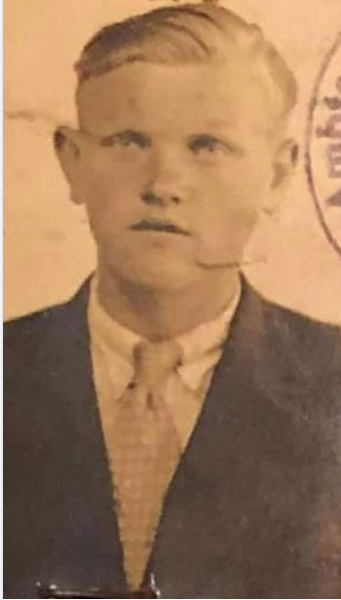
On November 14th 1947 a Dutch Vessel the MS Libelle sailed into Ballinacurra. Aboard was a 21-year-old Dutch sailor, Alko Mulder. At 8pm that evening he took a wrong turn on the pier when returning to the vessel and drowned.
A surviving witness recalls the body of the sailor lying face down in the mud down the Quay on the morning of November 15th. The Gardaí suggested throwing a rope to catch the body to recover it but Sonny O'Mahony waded out in the mud and water and brought Alko Mulder's remains ashore.
On the following evening, November 16th, an inquest was held in Midleton Courthouse under deputy Coroner William St. Clair Rice. The ship's engineer Nicholas Vink stated that the deceased sailor was a poor swimmer.
Garda Sergeant Whelan told the jury that the quay was lighted by three oil lamps. In its judgement, the jury expressed the opinion that the lighting on the quay was totally inadequate and requested that the Cork Harbour Board attend to this.
The MS Libelle left port on November 18th, bound for Weston Point UK, on the Manchester Canal, laden with 290 tonnes of Clay from the Cloyne Mineral Company.
The people of Ballinacurra came together and buried Alko Mulder here, and made a little headstone for him, which was fitting of community spirit here when people didn't have much during post-war rationing. Future Dutch ships entering and exiting the Port of Ballinacurra following his death used to give a longhorn salute when passing Alko's resting place.
Alko, a teetotal and never consumed alcohol, was a bachelor from Delfzijl, Holland and the son of Mulder Siebe and Havinga Zaantje. Five months later, on 26th April 1948, Mulder and Havinga were summoned to the town hall in Delfzijl and were informed of his death.
The Dutch Embassy assisted us with our enquiries for further information, however, record-keeping was poor during and after the Second World War, so we were unable to get Alko's shipping records.
Alko Mulder is buried behind the church, facing Ballyanan. His resting place was one of those recovered when our graveyard was reclaimed from nature. And now, he's been looked after again, with a clean resting place, and a modern headstone facing the path.
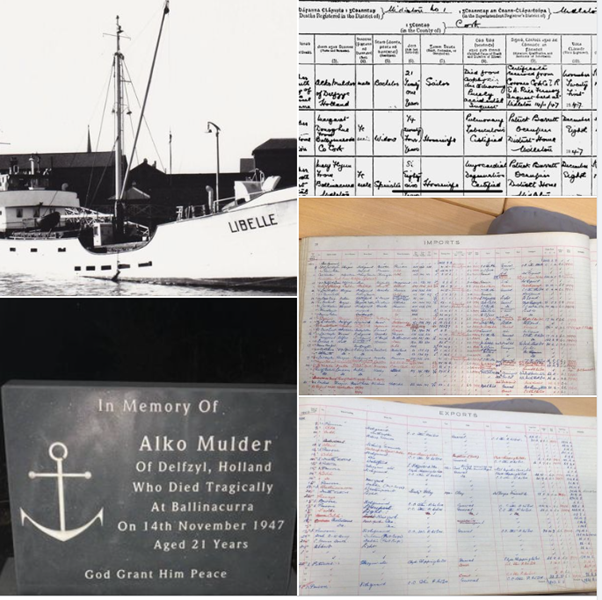
Daragh Devlin miraculously tracked Alko's ancestors in Delfzjil.
Ballinacurra 1947, photos of Alko Mulder's funeral were taken by the Cork Examiner for his family who couldn't make it. There is also a telegram of events of the day for our next snippet.
The hearse we believe is from Hyde's. Walsh's we believe is 7 Main Street. The RIC barracks was closed by then so the Gardaí were from the Midleton Barracks.
Please respect the history of these photos and not pawn them off as your own. We have permission to post these from his family.
Can you identify anyone in the photos?
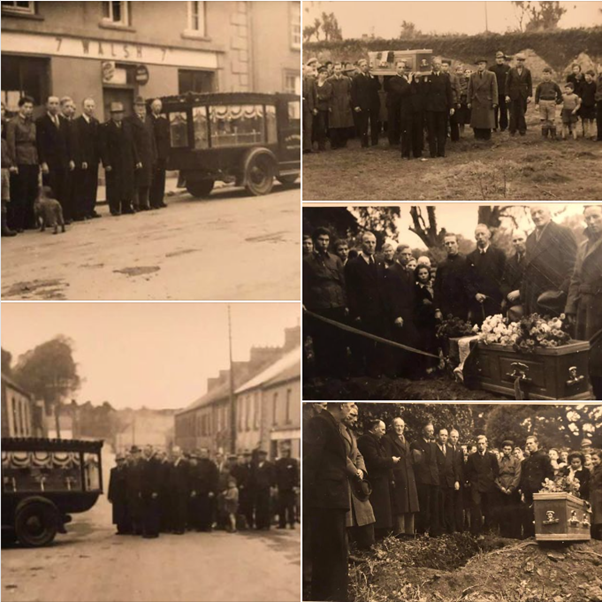
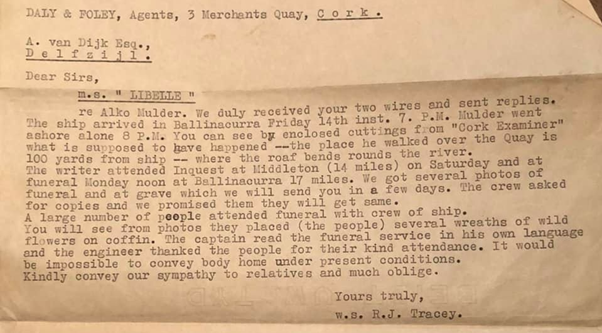
Special Thanks to the following:
- Captain Donal Madden, Port of Cork
- Billy Laar, Ballinacurra Resident
- John Ahern, Ballinacurra Resident
- Embassy of the Kingdom of the Netherlands
- Kieran O'Brien, Stonecutter, Midleton
- The graveyard caretaking staff
- And the people of Ballinacurra who laid Alko to rest
Watchman's Hut
Placeholder for Watchman's Hut Image
Dimensions: 800 x 600 pixels recommendedYou may wonder what our hut was for as you enter the gate. This Hut measures approx 10ft x 6.5ft with a fireplace and the person in it watched for graverobbers. There are no other remains of watchman huts in other graveyards that we are aware of, but I'm sure a history buff will correct us on this.
Grave robbing might seem like an idea from a Bram Stoker novel, but back in the 18th century it was a remarkably common activity contributed towards the evolution of medicine and surgery that we know today.
Up until 1832 It was only legal for surgeons to carry out anatomies on the bodies of convicted murderers who were hanged for their misdeeds (Albert Pierrepoint was our last hangman, retired in 1956) Nationally and naturally this wasn't enough bodies to satisfy the need of the countries medical experts, who would:
- perform autopsies
- train students
- sell tickets for observers
Obviously, there was money to be made on both sides, grave-robbing brought body snatchers money and surgeons could go about their business and have income from the students and observers. Also, in those days, bodies weren't buried 6ft under as they are now, so opening a grave and taking a body was fairly straightforward. Being next to the harbour, these nefarious individuals could make good their escape.
The Anatomy Act of 1832 was introduced, which stated that unclaimed bodies from workhouses could be used for dissection.
Ryng Family
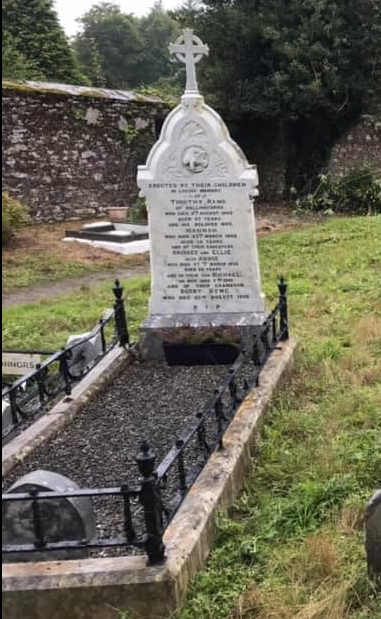
As you walk in the gate, you will see the watchkeepers hut. To the left is a still tended to grave of the Ryng Family.
Bobby Ryng (d:1988) was a famed Ballinacurra man who played senior with Carrigtwohill and interestingly lost 3 county finals, he won 2x Munster Colleges and All Ireland Senior and Minor Championships with Cork.
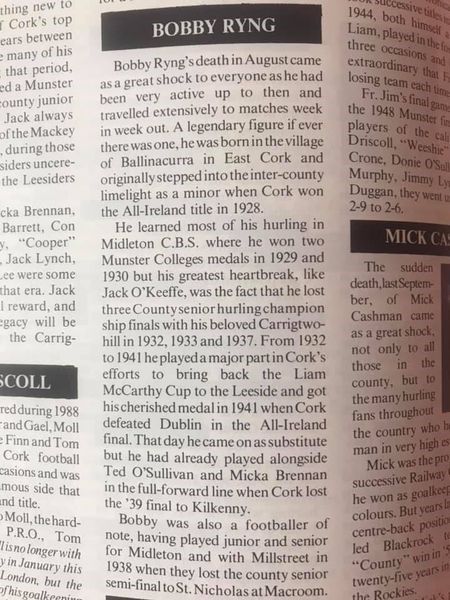
Ballinacurra Church

As you enter Ballinacurra Graveyard from Church Road, the ruins of the late-medieval church can be seen at the far end of the site, on the right-hand side. The site is known to have been an established ecclesiastical site, long before the current building was erected. It is thought that an earlier church may have occupied the site previously.
The church was built in and around 1550. It was a simple, single-cell church with steeply-pitched gables, built by hand of local limestone. A lancet window was added to the western gable at a later date. This gable and its beautifully detailed window are in remarkably good condition today, given that the church is at an advanced stage of ruination.
Background History
In the late 1100s, brothers Thomas and Robert Des Autres (later known as "Waters") were settled by the Anglo-Norman leader, Robert Fitz Stephen, who held Western Imokilly as his personal estate or Fief. Robert Des Autres built a castle at a place he called "del Core" and which was recorded in an Irish annalistic entry in 1206 as "An Cora".
Richard de Carew, the illegitimate son of Raymond Le Gros, son of William fitz Gerald of the famous Irish fitz Gerald dynasty, subsequently purchased the des Autres estate in the 1190s. Richard had inherited 30,000 acres of prime land, stretching from Mogeesha to Killeagh, Trabolgan and even parts of the Great Island (Cobh). He made his home at the castle in Ballinacurra which, in Richard's time was known as Castlecorth.
The de Barrys succeeded the fitz Geralds in power and they, in turn were eventually succeeded by the Geraldines in the1420s. It was during the time of the Geraldine rule that the church was built in Ballinacurra. It would have served as the parish church for the market town of Castlecorth. Midleton town was established much later, in the 18th century, meaning Ballinacurra/Castlecorth was the economic centre of the region at this time.
However, the 14th century was a tumultuous time; climate deterioration, bubonic plague, famine and civil unrest, coupled with the disinterest of the Barry clan, whose real interest lay much further West caused the decline of colonial market towns. A survey from the late 1560s shows no town or village at Ballinacurra. The church itself is recorded as having been in a ruinous state as early as 1615.
Ballinacurra church site is also a place of outstanding natural beauty and peace, away from the traffic and noise. It is a lovely spot to sit and watch the birds or watch the seasons change, away from the chaos of life.
Anne-Marie Kenneally